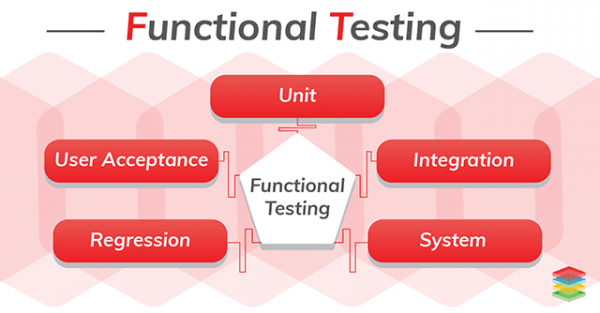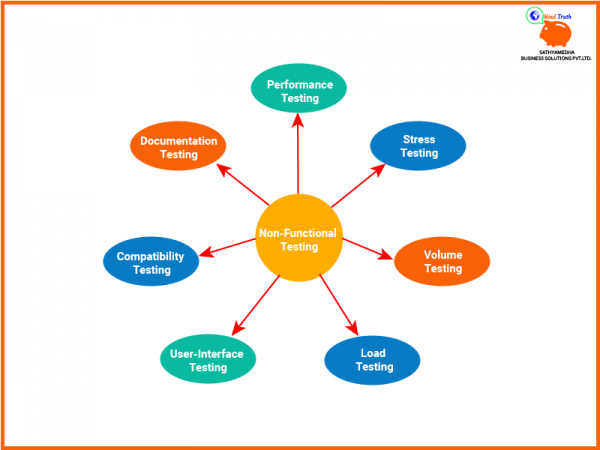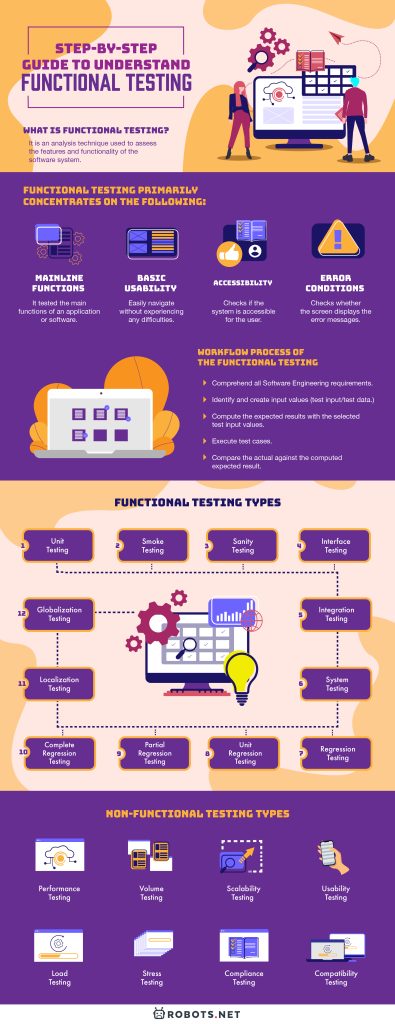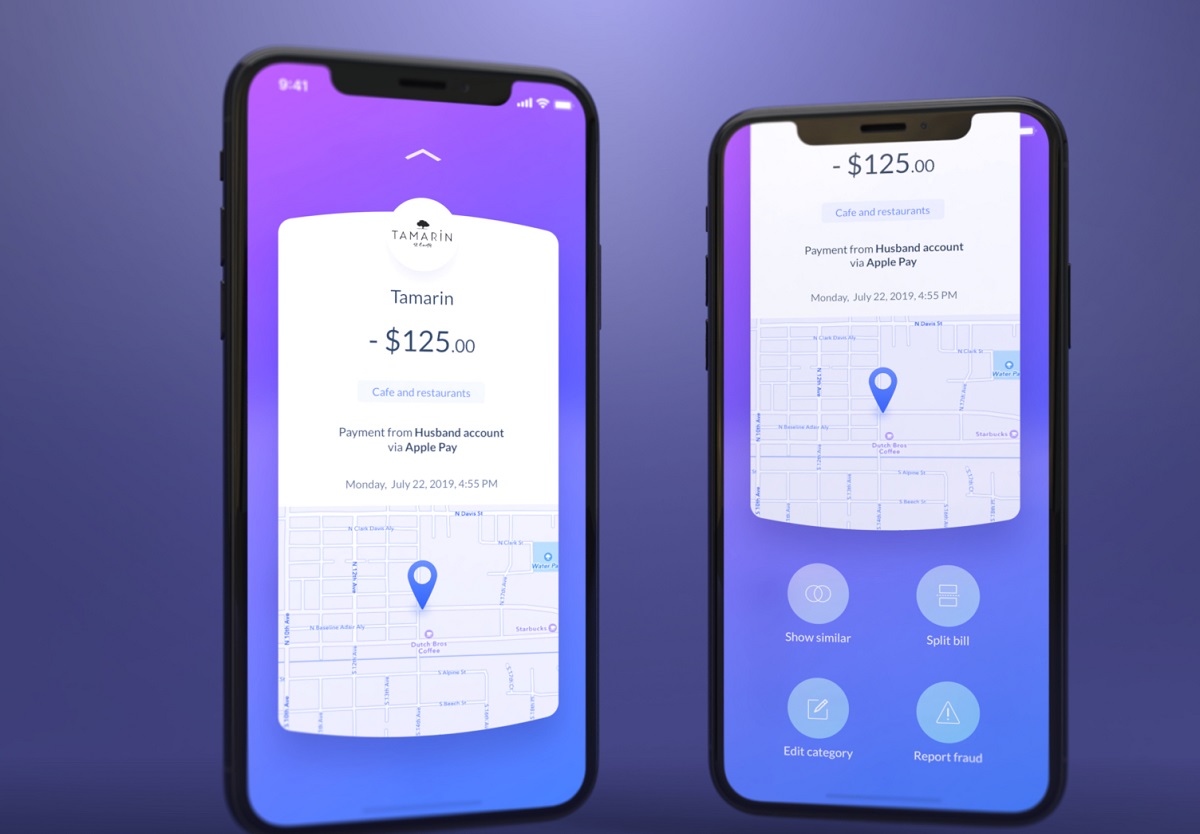This era we currently produce numerous software systems. For every successful system, it should undergo an investigation from the Quality Assurance team. Quality Assurance (QA) testing, therefore, plays a vital role in software development. A tool that would aid in assessing a product or software will be handy in QA testing. This is where functional testing comes in.
This article will help you comprehend and appreciate what functional testing is. Also, its significance to the world of software development. So when we talk about delivering quality software, functional testing has the chart-topping ROI done with the help of real data. So what is Functional testing?
What is Functional Testing?


It is an analysis technique used to assess the features and functionality of the software system. Usually, functional testing is an automated process. In this process, the QAs determine if the developed software operates according to the pre-determined requirements. It is a type of software testing that validates the software system against the requirements and specifications. In simpler terms, we can describe it as testing that checks an application, system, or website to ensure that it will perform accordingly.
Functional testing involves using Black-box testing techniques. In this technique, the tested internal logic of the system is unknown to the tester. Also, it is not concerned about the source code of the application. Functional testing is only concerned with validating system functionality. As intended and should cover all the possible scenarios including failure paths and boundary cases. This testing checks User Interface (UI), Application Programming Interface (APIs), Database, Security, Client/Server communication and other functionality of the application under test.
What is Functional testing being tested some might asks? Generally, functional testing checks the functionalities of the software system. And it primarily concentrates on the following:
- Mainline Functions
- Basic Usability
- Accessibility
- Error Conditions
Workflow Process of The Functional testing
Generally, the process workflow of a functional test includes the following steps:
- Comprehend all Software Engineering requirements.
- Identify and create input values (test input/test data.)
- Compute the expected results with the selected test input values.
- Execute test cases.
- Compare the actual against the computed expected result.
Functional Testing Types


The process of Functional testing involves a series of tests. Below are some of the prominent types of Functional Testing:
1. Unit Testing
In this testing, the developers perform it. They write different code units that relate or not to achieve a particular functionality. Developers also write scripts that can test if the individual components match the requirements. This process usually requires writing unit tests. It will call the methods in each unit and validate the passed parameters, and the expected value will be return.
In unit testing, code coverage is important because it ensures that test cases exist to cover the following:
- Line Coverage
- Code Path Coverage
- Method Coverage
2. Smoke Testing
This next level of testing will be performed after the release of each build. This is to ensure that the software stability is intact and not facing any anomalies. Smoke testing is also called “Build Verification Testing”.
3. Sanity Testing
This testing will be performed when the testers don’t have much luxury of time. Sanity testing is the level of testing where the Quality assurance team verifies the menus, functions, commands and other major functionality available in the product. It will also check if the project is working perfectly, both by itself and in combination with other elements. Sanity testing is usually performed after Smoke testing.
4. Interface Testing
The interface is a connection that integrates two components. It is actually a software that consists of sets of commands, messages, and other attributes. It enables the communication between a device and a user. Therefore, Interface testing is a software testing type that verifies if communication performance. It checks the communication between two diverse software systems.
Interface testing includes testing of two main segments. These are the following:
- Web server and application server interface
- Application server and Database server interface
Basically, interface testing is done to:
- Check if the servers are properly executed or not
- You can check if you can handle and deal with the errors properly
- Check the outcomes when the connection to a web server is reset in between
5. Integration Testing
Integration testing is another area of testing where it integrates software parts logically and tested as a group. When a system requires multiple functional modules to work effectively, you can use this testing. This is to ensure that the individual modules, usually coded by different programmers. It works coherently as expected when functioning in combination with each other. The purpose of Integration testing is to expose deficiencies and defects in the interaction. Once assimilated, the interaction between the software modules occurs. It usually focuses on checking data communication amongst the individual modules.
6. System Testing
Defined as testing that performs on a complete system to verify if it works as expected after the integration of all the modules or components. The purpose of this test is to evaluate and validate the system’s compliance with the specified requirements. System testing is therefore done after Integration testing
7. Regression Testing
In the software development cycle, this testing will run after there’s a change to a codebase. Codebase such as new code, debugging strategies and others. This is to ensure that it does not disrupt the existing functions, does not introduce unintended breaks, or trigger some instability. Regression testing addresses a common issue that most developers or programmers often face. It is the emergence of old bugs while the introduction of new changes.
So why do we need to run Regression testing? Imagine this: if a project does not implement a stringent version control system, it will be very difficult to trace. Also, it is hard to determine which change introduced the bug. Therefore, it is important to have robust regression testing in any project. Various Regression testing techniques will employ to the project. However, if you are considering performing regression testing into a mature project, you don’t need to implement it for every element in the project.
These are the following regression techniques that might be very handy in your system:
8. Unit Regression Testing
This approach uses a bird’s eye view philosophy to test the code. The tester has a list of items to test every time a change transpires. This simple method is the perfect way to start regression testing.
9. Partial Regression Testing
It is an approach that divides the project into logical and coherent units. It works together to form the application. In this technique, you can select the most critical units for the application. Also, the specific cases are defining for them, while performing unit regression testing for the rest of the modules.
10. Complete Regression Testing
This final technique is the most detailed form of regression testing. You have to take a comprehensive view of the codebase to identify all functionalities. It can affect usability on breaking and write detailed tests for each of them. This approach may be a bit time-consuming but you can apply for its benefits from the early stages of the project development.
11. Localization Testing
This is another technique in software testing that checks the product to assure that it acts according to the local culture or settings. What does this mean? It means that this level of testing is a process of customizing software applications as per language and country. Content and UI (User Interface) are the major affected areas in the localization testing. It tests the application whose UI, default language, currency date, time format, and documentation design per targeted region or country. In short, it ensures that the application is capable enough for use in that specific country.
12. Globalization Testing
You can perform this testing to ensure that the system application can function independently from the geographical and cultural environment. This means that Globalization testing ensures it’s used all over the world and accepts all the language texts. The difference between Globalization testing and Localization testing is it focuses on users as the generic user base. The latter, however, focuses on a small group of users in a given culture or locale.
There are several tested aspects during the Globalization testing and these are the following:
Sensitivity to the language vocabulary
To verify if the application uses the proper vocabulary for each language, you can use different language translators. This is an important aspect since a global product need to support many languages. Therefore, in this testing, you can switch the application to different languages. You can also test the response and the performance of the application. For example:
India: Hindi and English
US: English
Date and time formatting
The formats of date and time may differ from one place to another. Therefore, an application should support all kinds of formats including the 24 and 12-hour notation. For example:
US: mm/dd/yyyy
Currency format
Currency may vary from one country to another. So again, the application should support all kinds of currency formats. The application should display the appropriate unit and symbol of currency.
For example:
US: Dollar
Phone and mobile number formatting
Every country has a different phone and mobile number formats. Also, the International Subscriber Dialing (ISD) differ from each country. Therefore, the application should support all formats.
For example:
People’s Republic of China: +86
Address formatting
Address formats also differ from one country to another, although some may have the same formats. However, to cover all and ensure that you can use the application all over the world. The applications should support all types of formats in address formatting. For example:
People’s Republic of China: Country/ Province/ Municipality/ Town/ Street or Road/ Building name/ Floor/Level/ House/ Flat Number/ Company Name/ Addressee
Hungary: Addressee (Name or Company Name)/ City or Town/ Street name, Number, and floor/door/, or P.O Box Number/ Postal Code
Zipcode format
The zip code also varies from one country to another, or may even vary from one place to another in the same country. For example:
Afghanistan: 09000
Generally, globalization testing is important since this makes the software product more flexible and scalable. Also, it saves time and effort for the over-all software testing, and most importantly, globalization testing is less costly.
14. User Acceptance Testing
This testing is also called as “Beta” or “End-User” testing. User acceptance testing is checking the software by the user or client to determine if it is acceptable or not. It is the last testing carried out before the software goes live. Therefore, the user checks and measure the software if it is suitable for the purpose.
We have finished with the rundown of some of the different Functional Testing techniques. But know this, an effective and successful product must be thoroughly tested. This means that Functional testing might not be enough to assess the software as a whole. Functional and Non-Functional Testing are the categories of this testing. So what is the difference between the two?
Non-functional Testing Types


Since you can perform functional testing verifies and test its functional specification provided by the client. Non-Functional Testing, on the other hand, checks the performance, reliability, scalability and other non-functional aspects of the software system. Both are equally important and both affect client approval and satisfaction. Functional testing is usually executed first before Non-functional testing.
But before we draft a summary conclusion of their differences, let me discuss briefly some of the different Non-Functional Testing types.
Performance Testing
Known as “Perf testing”, this checks the speed, response time, reliability, resource usage and scalability of a software program under their expected workload. The purpose of Performance testing is to eliminate performance bottlenecks in the software. It uncovers what needs to improve before the product goes to market. If Performance testing is not done, you may encounter several issues. Issues such as running slow while having multiple users. In addition, inconsistencies across different operating systems and poor usability.
Here is the checklist in conducting Performance Testing:
-
The response time of application. This means that you should verify the application. Verify its loading speed or any possible input given to the application, it’s output, how much time you refresh the browser and its likes.
-
Throughput. This means that you should verify the application should on the number of transactions completed during a load test
-
Environment. This means that the environment set up of the application should be the same as the live environment else, the results will be totally different
-
Process time. It is the process of verifying and testing the activities (e.g. import and export of excel) or any calculations in the applications.
-
Interoperability. You should verify the interoperability. It means that software or application should be able to inter-operate with the other software or application systems
-
Extract, Transform, Load (ETL). This is the testing and validation while doing the extracting, transforming and loading of data from one database to another.
-
Increasing Load. You should verify the increasing load of the application.
Volume Testing
When there is a large data involved, this testing evaluates the behavior of the software. The objective of Volume testing is to check the software application’s performance under varying database volumes.
Here are some key points to keep in mind:
-
When software subjects to a large amount of data, volume testing checks the limit where the software fails.
-
You can generate maximum database size, multiple clients query to the database and create a larger report.
Scalability Testing
The objective of scalability testing is to determine the software application’s effectiveness in ”scaling up”. This testing support an increment in the user load. This means that it verify if the application is capable enough to handle traffic increase. Also, the number of transactions, data, volume, etc. When the size of data changes, the system should work as expected.
Usability Testing
This is quite similar to User Acceptance Testing, which is a Functional Testing Type. Both serve the same purpose and that is to deliver quality products. However, Usability testing varies slightly from User Acceptance Testing.
Usability testing performs to ensure that clients can use the product with ease. This is usually done towards the middle and the end of the design process. It makes incremental changes to the website design when you discover some issues.
User Acceptance testing, on the other hand, performed by the client to ensure the product is working accordingly. This is usually near the end of the design process. This is generally used for the developers to prove to the client that the project is complete and ready for use.
Load Testing
You conduct nonfunctional testing to understand the behavior of the application under a specific expected load. Load testing determines a system’s behavior under both normal and at peak conditions. Load testing can identify bottlenecks before the application goes live. This is also used to identify whether the infrastructure used for hosting the application is sufficient or not. Load testing can also check how many simultaneous users the application can manage.
To summarize, the primary objective of load testing is to define the maximum amount of work a system can handle without significant performance degradation.
Stress Testing
This is also known as “Fatigue testing”. Stress testing involves the testing of an application under extreme workloads. It is to check how it handles very large traffic or high data processing. The objective of this test is to identify the breaking point of an application beyond its normal operational capacity. Stress testing, therefore, determines the stability also. This is to ensure that the software does not crash in conditions of insufficient computational resources. Resources such as memory, disk space, network request, and etc.
Thus, Stress testing tries to break the system under test by overwhelming its resources. Therefore, the main purpose of Stress testing is to make sure that the system fails and recovers easily. You can also use Stress testing to uncover data corruption and hardware issues.
Compliance Testing
This type of non-functional testing is also known as “Conformance testing”. Compliance testing validates whether the system developed meets the organization’s prescribed internal/external standards. The depth of Compliance testing could range from a high-level audit on a sampling basis. This is to a detailed investigation of each specified standard. It evaluates the documentation of the project to check for completeness and reasonableness.
Portability Testing
This non-functional testing determines the ease or difficulty in which software components you can move from one environment to another. For example, you test the application if it works effectively when transferred from Windows 2000 to Windows 10. The test results obtained in Portability testing helps to find out how software components can move. It measures the maximum amount of effort required to transfer from one system to another system. Or the environment and complete the documentation updates.
Compatibility Testing
A non-functional software testing that checks whether the software is proficient enough to run on different hardware. In addition, to different operating systems, applications, network environments or even mobile devices. It evaluates the application’s compatibility with other hardware/software with minimum and maximum configuration. The application or system could have different responses to different versions, resolution, internet speed, configuration and much more. Therefore, You should test it in all possible manners. This is usually performed in an incremental manner throughout the software development cycle.
Compatibility testing is different from Portability testing. It deals with two or more components that can run in the same environment at the same time without adversely affecting the behavior of one another. On the other hand, Portability testing deals with moving the component from one environment to another.
In short, Compatibility testing deals with testing two different applications in the same environment while Portability testing deals with software components across multiple environments. Remember, customer satisfaction increases with a well-tested product. Thus, conducting Compatibility testing can help in assessing and improving the product.
Having defined Functional and Non-functional testing and citing some different testing types.
The Differences between Functional Testing vs Non-functional Testing
Here is a summary of the differences between the two:
| Functional Testing | Non-Functional Testing |
|---|---|
| Executed before non-functional testing. | Executed after the functional testing. |
| Based on business or client’s requirements. | Focuses on the client’s expectations and performance requirements. |
| Easy to define requirements for functional testing. | Difficult to define requirements for non-functional testing. |
| It helps to validate the behavior of the application; tests whether the actual result is working as it is supposed to be. | It helps validate the performance of the application; tests response time, speed, and other non-functional aspects of the software under specific conditions. |
| Carried out to validate software actions; helps enhance the behavior of the application. | Carried out to validate the performance of the software; helps improve the performance of the application. |
| Functional testing is carried out using functional specifications. | Carried out using performance specifications. |
| Easy to execute by manual testing (Black Box Testing Method). It can also be tested using automation tools. | Difficult to execute by manual testing; more feasible and effective to use automated tools. |
| Describes what the product does; checks the operations and actions of an application. | Describes how the product works; checks the behavior of an application. |
Conclusion
Testing and Quality Assurance indeed plays a vital role in software development. It determines the success and effectiveness of a product that satisfies or exceeds a customer’s satisfaction. In the development of a software product, the scope is so massive. To fully comprehend, assess and evaluate a product, several techniques should be employed. That is to guarantee that the quality of the product shall pass and surpass the requirements and anticipations of a client.



























